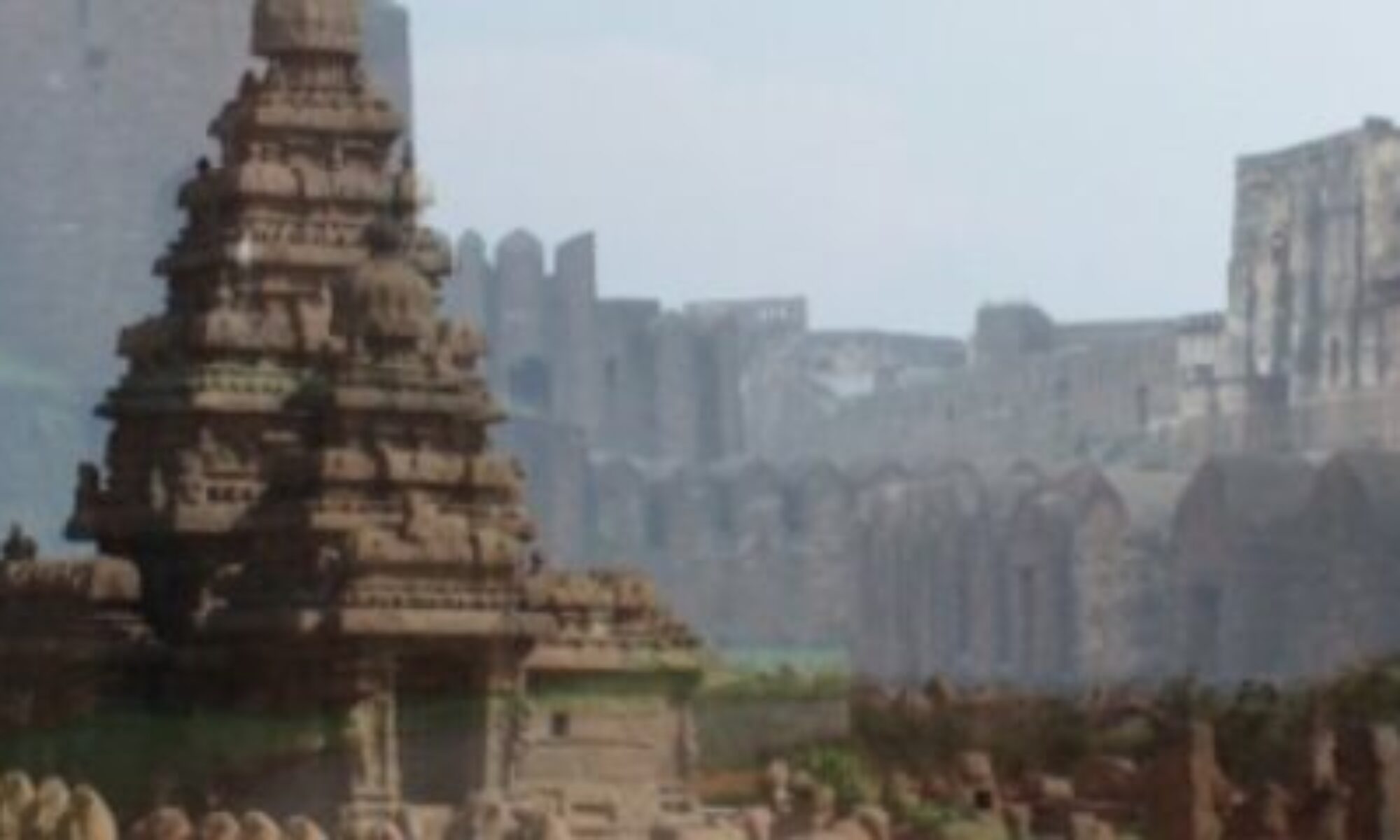As mentioned in the previous post, the Undavalli cave is four storeys in height one above the other, but there is a fifth storey in front, a little detached, but which may have been intended to be connected with and made part of the original design. The lowest of the four connected storeys is so entirely unfinished, and we cannot even guess what form it was ultimately intended to take. If the cave at Undavalli is carefully exa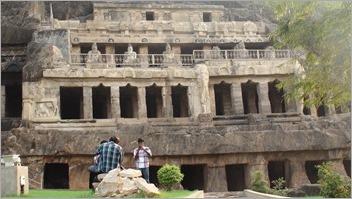 mined, it seems almost certain that it looks like the three sides of the court were really intended to represent the three sides of a pyramidal vihara turned inside out.
mined, it seems almost certain that it looks like the three sides of the court were really intended to represent the three sides of a pyramidal vihara turned inside out.
The center of the ground floor was with three intercolumniations in width. The sides of the second storey having, or being intended to have, five, which was a greater number than it was possible to give to the center from its situation, flattened out on the rock. In the third storey they were all reduced to three intercolumniations, and the uppermost storey of all was only the dome which all the viharas had, flattened out.
The front of the lower storey extends about 90 feet in length, and the excavation has been carried inward 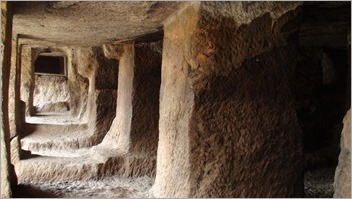 to various depths, leaving portions of three rows of massive square stone pillars partially hewn out. On the façade was carved an inscription in one line in the Vengi character of about the seventh or the eighth century, probably during the time of the Chalukyas. The second floor is of much greater area, and has originally consisted of four different apartments; a door has been broken through the dividing wall between the third and fourth, thus throwing them into practically one apartment. The south or left side hall is about 19.5 feet square, the roof being
to various depths, leaving portions of three rows of massive square stone pillars partially hewn out. On the façade was carved an inscription in one line in the Vengi character of about the seventh or the eighth century, probably during the time of the Chalukyas. The second floor is of much greater area, and has originally consisted of four different apartments; a door has been broken through the dividing wall between the third and fourth, thus throwing them into practically one apartment. The south or left side hall is about 19.5 feet square, the roof being 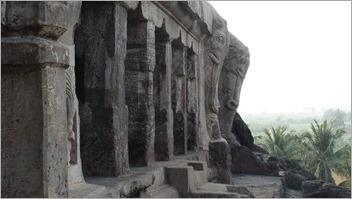 supported by two plain pillars in front and two inside, all with heavy bracket capitals. At the back is a shrine cell, 10 feet square, with an altar in the center and a tunnel for water around it, for the conveyance of which to the outside a small channel was cut under the middle of the threshold. The front of this hall is ascended to by eight steps from a platform 10.5 feet broad in front of it. Outside is a cell in the left end of the platform, and behind it is a still smaller one. On the rock above is a frieze of elephants and lions.
supported by two plain pillars in front and two inside, all with heavy bracket capitals. At the back is a shrine cell, 10 feet square, with an altar in the center and a tunnel for water around it, for the conveyance of which to the outside a small channel was cut under the middle of the threshold. The front of this hall is ascended to by eight steps from a platform 10.5 feet broad in front of it. Outside is a cell in the left end of the platform, and behind it is a still smaller one. On the rock above is a frieze of elephants and lions.
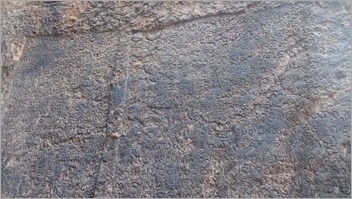 The façade above the hall has a frieze of geese; above this is a heavy projecting member, having a window like a chaitya. On the rock on the north side of the platfo
The façade above the hall has a frieze of geese; above this is a heavy projecting member, having a window like a chaitya. On the rock on the north side of the platfo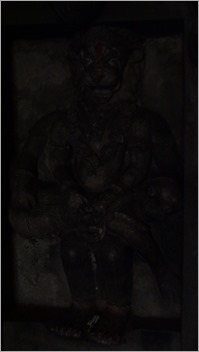 rm is a very long inscription in Telugu, recording large donations to the temple. This inscription is dated around 13th century, thus showing that it was still considered sacred in the days long after Buddhism had entirely disappeared from India. To the right of this, and projecting about 10 feet further forward, is the principal or central hall of the whole 29 feet wide by 31 feet deep and varying in height from 7 feet to 8 feet. The roof is supported by sixteen square pillars chambered in the middle of the shafts, arranged in four parallel rows. At the back is a shrine about 13.5 feet square with an empty altar. On each side of the shrine are two standing figures cut in niches, one of them being Narasimha or the main-lion avatar of Vishnu. Over the head of the door is a makara torana.
rm is a very long inscription in Telugu, recording large donations to the temple. This inscription is dated around 13th century, thus showing that it was still considered sacred in the days long after Buddhism had entirely disappeared from India. To the right of this, and projecting about 10 feet further forward, is the principal or central hall of the whole 29 feet wide by 31 feet deep and varying in height from 7 feet to 8 feet. The roof is supported by sixteen square pillars chambered in the middle of the shafts, arranged in four parallel rows. At the back is a shrine about 13.5 feet square with an empty altar. On each side of the shrine are two standing figures cut in niches, one of them being Narasimha or the main-lion avatar of Vishnu. Over the head of the door is a makara torana.
The four pillars in the back row are muc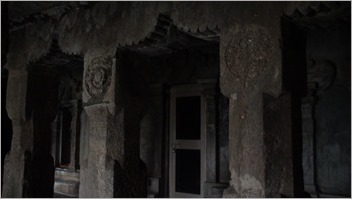 h weatherworn, and some of them are broken away. They have been sculpted with arabesques and lotuses, and on one a group of a man and his wife with a female attendant. The pillars in the next and front rows are also almost entirely destroyed. The bases and capitals of the second row are covered with lotuses, animal and human figurines. The third apartment has originally consisted of two rooms and its roof is supported by four pillars bearing lotus ornaments. At
h weatherworn, and some of them are broken away. They have been sculpted with arabesques and lotuses, and on one a group of a man and his wife with a female attendant. The pillars in the next and front rows are also almost entirely destroyed. The bases and capitals of the second row are covered with lotuses, animal and human figurines. The third apartment has originally consisted of two rooms and its roof is supported by four pillars bearing lotus ornaments. At 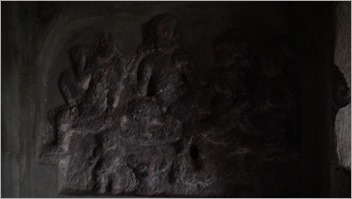 the back of the cell is a pedestal for the image. On the west wall is a sculpture, perhaps Vishnu in which the principal male figure is seated on a couch with his wives and attendants, and with musical performers represented in front.
the back of the cell is a pedestal for the image. On the west wall is a sculpture, perhaps Vishnu in which the principal male figure is seated on a couch with his wives and attendants, and with musical performers represented in front.
A stair in the left side of the large hall leads up to the third storey and lands in a great hall 52 feet long by 30 feet deep, including the verandah. First there is a long verandah, with six pillars and two pilasters in front; then in the back of the verandah, separating it from the hall, are four pillars in the middle, and a wall at each end extending the length of the opening between the pillars and carved in f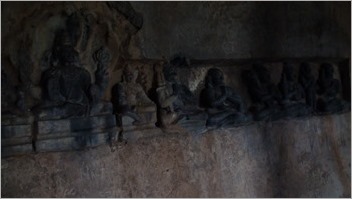 ront with a dvarapala. On the front sides of the upper portions have been sculpted the avatars of Vishnu and other figures. At the left end of the back wall, and partly on the return of the end wall, is a figure of Vishnu seated on the body of a serpent Anantha, while the hoods of the snake overshadow his head. He is four armed, holding the conch and wheel emblems in his hands and attended by Lakshmi. At the sides are thirteen figures each about 2 feet in height, listening to his discourse or worshipping him, but two of them are broken away. In the right end wall of this hall has been
ront with a dvarapala. On the front sides of the upper portions have been sculpted the avatars of Vishnu and other figures. At the left end of the back wall, and partly on the return of the end wall, is a figure of Vishnu seated on the body of a serpent Anantha, while the hoods of the snake overshadow his head. He is four armed, holding the conch and wheel emblems in his hands and attended by Lakshmi. At the sides are thirteen figures each about 2 feet in height, listening to his discourse or worshipping him, but two of them are broken away. In the right end wall of this hall has been 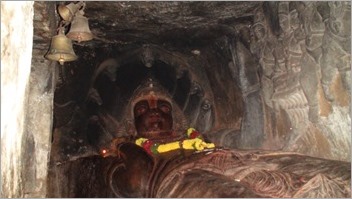 cut a gigantic recumbent figure of Narayana, 17 feet long, resting on Sesha, the great serpent, whose seven hoods canopy his head. At his feet are two colossal figures, 8 feet high, and above and below the extended arm of Vishnu are attendant figures, with Brahma seated on the lotus that springs from Vishnu’s navel.
cut a gigantic recumbent figure of Narayana, 17 feet long, resting on Sesha, the great serpent, whose seven hoods canopy his head. At his feet are two colossal figures, 8 feet high, and above and below the extended arm of Vishnu are attendant figures, with Brahma seated on the lotus that springs from Vishnu’s navel.
The upper storey is reached by a series of steps in the rock at the left side. It represents the circular or domical termination which crowns every square pyramidal temple, in the Dravidian style of architecture. Here it is of course flattened out to meet the 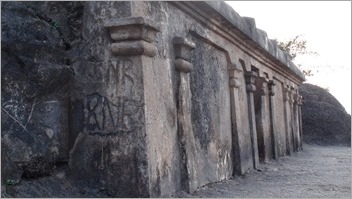 exigencies of rock construction. It stands on a plain platform over the roof of the verandah of the third storey with three circular cells in the back wall with a bench rounded each. They are apparently unfinished, but their existence here is interesting, as showing that the upper storey or domical part of these viharas was intended to be inhabited.
exigencies of rock construction. It stands on a plain platform over the roof of the verandah of the third storey with three circular cells in the back wall with a bench rounded each. They are apparently unfinished, but their existence here is interesting, as showing that the upper storey or domical part of these viharas was intended to be inhabited.
Though this cave was initially ascribed to the Buddhists, it is beyond doubt that this is Brahmanical as it is impossible that all Buddhist details, if they ever existed, could have been so altered and obliterated as to be no longer recognizable. This style is more similar to the cave temples in Mahabalipuram which again dates to the same time, i.e. 7th century.
